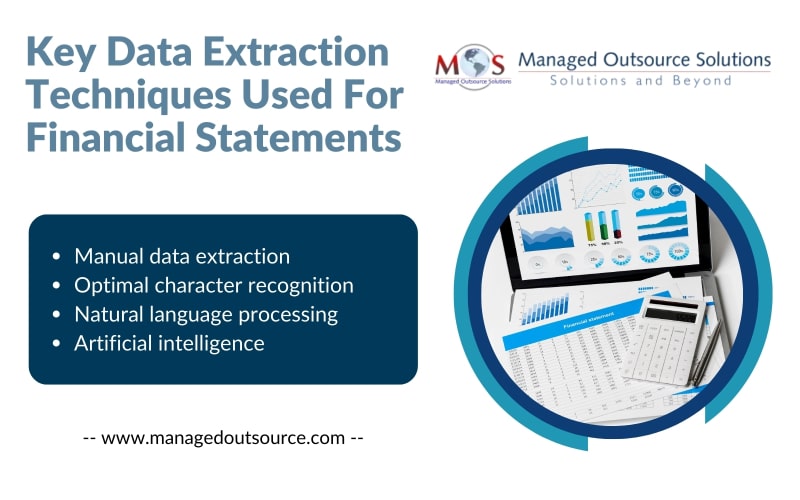In today’s data-driven business landscape, the potential of big data analysis is surging. Financial data serves as the cornerstone of financial analysis for a business entity. Extracting key data from the financial statements of a company and analyzing it can provide valuable business insights. The extracted data is converted into a clean, structured format for critical financial analysis. However, navigating through the vast amount of unstructured financial data in various formats can be a challenging task. By hiring data mining services, you can ensure that your financial data extraction is handled efficiently. Outsourcing also saves time and resources and allows you focus better on your core business operations.
What are Financial Statements?
Financial statements are the formal documentation of the financial activities of an organization and offers a window into its financial position. These business records are compiled to assess the financial sustainability of the company over a period of time. Financial statements are utilized by professionals such as investors, analysts, and executives to perform a complete assessment of areas such as profitability, cash flow, assets and liabilities in a company. The three main financial statements are:
- Balance sheet
- Income statement
- Cash flow statement
What is Financial Data Extraction?
Financial data extraction optimizes a business’s workflow by extracting raw data from numerous sources, such as a balance sheet, bank statement, and invoices, to create a clear, structured financial report. This process is integral to facilitating robust financial analysis and comprehensive understanding of the financial performance of an entity. An accurate and timely financial report is required to assess the company’s financial status, spot trends, and make strategic business decisions.
How Does Financial Data Extraction Help Businesses?
Financial data extraction provides essential insights for daily and long-term business decisions. Stakeholders use this data to assess performance, financial health, and growth potential, guiding sound investment choices. By investing in robust extraction tools, businesses can gain deeper insights into revenue trends, cost patterns, and risk factors. This process enhances scalability by efficiently managing large volumes of data tailored to specific needs. Automated extraction implements quality control measures, ensuring data accuracy and reliability while streamlining operations with real-time financial insights.
Key Financial Data Extraction Techniques
Let’s explore the various techniques employed for extracting information from financial statements:
- Manual Data Extraction
Many companies still rely on manual data extraction methods for financial statements. To extract the necessary data, their staff gord through various documents manually, and reads and sorts them. Manual data extraction can be a complex and burdensome task due to the lengthy process of extracting data from various sources, such as income statements, investment data, and payroll records. Since the financial decisions of a company should be precise and reliable, the extracted data has to be accurate and error-free. However, manual data extraction is not only a time-consuming and resource-intensive but also highly prone to human error, leading to inaccurate analysis and poor business decisions.
- Optimal Character Recognition
Optimal character recognition (OCR) is a vital technology commonly used in large-scale financial data extraction. This technology translates printed or scanned papers of financial documents and image-based financial reports into machine-readable and editable data through pattern matching. OCR enables the conversion of large volumes of unstructured data from bank statements, invoices, and receipts into structured, presentable reports suitable for analysis. OCR reduces human error and saves time by expediting data retrieval. Although better than manual extraction, traditional OCR comes with its own limitations such as, standardized templates, selective data extraction, and irregular formatting.
- Natural Language Processing
Natural language processing for data extraction automatically extracts valuable information from unstructured text data within financial statements. The goal of NLP is to transform unstructured data into structured data that is suitable to be searched, visualized, and analyzed. It is an intelligent document processing technique that uses unique NLP approaches such as named entity recognition (NER), sentiment analysis, and topic modeling to extract valuable financial metrics from documents. The extracted data is converted into structured format by understanding the content, context, and semantics present within financial documents. This technology transforms financial data extraction by going beyond the simple OCR with its automated capabilities to process contextually relevant, accurate data for analysis. However, the main challenge that this technology faces is dealing with the complexity and nuances of financial language. NLP machines must be trained on labeled data.
- Artificial Intelligence
Extracting data from financial statements has historically been an intensive and challenging process, and is being replaced by AI-powered automated tools, increasing efficiency and reducing risk of errors. By leveraging advanced algorithms and neural networks, advanced software solutions with ML and AI provide the most accurate data extraction. AI is a cutting-edge technology designed to understand the peculiarities of financial terminology. It goes beyond traditional data extraction processes by seamlessly extracting key data points, analyzing trends, and generating real-time actionable insights. Utilizing AI for data extraction techniques, significantly enhances productivity and resource allocation by eliminating repetitive, manual tasks. AI further enhances data quality by recognizing patterns and anomalies in financial documents. Finally, AI improves overall data management and financial reporting by providing comprehensive, meaningful, and concise financial information.
Tips to Manage Extracted Financial Data
To ensure efficient management of extracted financial data, follow these steps:
- Ensure data security – Data security is the primary step in data management. Take steps to safeguard financial data against security breaches and protect sensitive information such as financial transactions, incomes, and liabilities.
- Data integrity measures – Cross check extracted data with source documents to validate the accuracy of extracted data and rule out any inconsistencies or errors.
- Monitor data and compliance – Enforce mandatory and consistent adherence to rules and regulations of financial data extraction to improve compliance. Regular, concise, and detailed monitoring of extracted data can promote data integrity by eliminating errors and potential compliance issues.
- Analysis tool integration –Integrate automation analysis tools into existing systems to improve accuracy, better data collection and storage, and reduces the risk of errors.
- Continuous improvement – The financial data extraction method is a multi-step process. Continuous evaluation and analysis of extracted information is necessary to gain insights into the company’s financial health.
Partnering with a business process outsourcing company that provides data mining solutions can help you implement efficient financial data extraction processes and obtain the information you need for strategic decision making.





